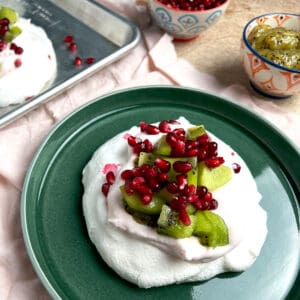Mini Pavlovas (With Rose Cream & Kiwi Compote)
These easy and elegant mini pavlovas are topped with rose cream and kiwi compote and finished with fresh chopped kiwi and pomegranate seeds.
WANT TO SAVE THIS RECIPE?
Ingredients
- 5 egg whites (see notes)
- ¼ teaspoon salt
- ½ teaspoon cream of tartar
- 1 cups superfine sugar (see notes)
- 1 teaspoon vinegar (see notes)
- 1 teaspoon vanilla extract
- 2 teaspoon cornstarch
- ½ lemon
Whippes Rose Cream
- 1 cup heavy whipping cream
- 2 tablespoon confectioners sugar
- ½ teaspoon rose water
- 2 drops red food coloring (optional)
Kiwi Compote
- 2 kiwis
- 1 tbsps cornstarch
- 1 lemon
- ¼ cup water
Fruit
- 2 kiwis
- ½ pomegranate
Instructions
Baking The Pavlova
- Preheat your oven to 275°F
- Trace 4 four-inch circles on a sheet of parchment paper. (see notes)
- Separate the egg whites, making sure no drops of yolk remain.
- Weigh the whites to make sure you have no more than 150 grams of liquid
- Weigh your sugar to ensure you have no more than 200 grams of sugar, and grind it in a small coffee grinder until you have a super fine texture. (see notes)
- Make sure your mixing bowl is well washed and dried and rub the ½ lemon all over it (see notes)
- Whip the egg whites, salt, and cream of tartar until you get medium-stiff peaks.
- Start adding in the sugar slowly, 1 tablespoon at a time, till you get stiff peaks. (see notes)
- Make a slurry of the vinegar, vanilla and cornstarch and gently fold it in.
- Transfer the mixture to the parchment, staying inside the 4-inch circles you traced. (see notes)
- Bake for 15 minutes at 275 degrees farenheit, then reduce the heat to 225 degrees farenheit and continue to bake for an additional 45 minutes. (see notes)
- Once the Pavlova is done, DO NOT remove it from the oven. Leave it in the oven for atleast 4 hours so it cools down gradually. (see notes)
Whipped Rose Cream
- Add the heavy whipping cream, confectioner sugar, rose water, and red food coloring in a mixing bowl.
- Whip until you have a firm texture and set aside in the fridge.
Kiwi Compote
- Peel and chop the kiwis and cook them with the lemon juice, sugar, and water for 15 minutes at low heat.
- Use an immersion blender to puree the mixture and set aside to cool.
Fruit
- Peel and chop the kiwi and place it in the fridge to keep it chilled.
- Deseed the pomegranate and set the seeds aside to use later.
Assembling The Pavlovas
- Set the completely cooled pavlovas on a clean surface, making sure to handle them gently as they can fall apart easily.
- Add a quarter cup of the whipped cream to the top.
- Place 2 tablespoons of the kiwi compote on top.
- Garnish with the prepared fruit, and enjoy.
Notes
Egg Whites— Weighing the egg whites is crucial to the success of this recipe. Counting the number of eggs is insufficient, as eggs don't come in uniform sizes.
Superfine Sugar—Superfine sugar is granulated sugar ground to a fine consistency, allowing it to dissolve completely. Powdered sugar contains cornstarch and will prevent the pavlova from having a glossy finish. It's best to weigh the sugar and ensure the perfect egg-to-sugar ratio.
Vinegar - I use distilled white vinegar for my Pavlova, but you can use any light-colored variety. I wouldn't recommend dark vinegar, as you want a lovely light-colored Pavlova.
Tracing Your Circle—Flip the parchment upside down once you trace your circle. You'll still see the circle, but the pencil lines won't transfer onto your Pavlova. I like to make four Pavlovas from my egg-white mixture, but if you want six tinier ones, draw 2.5-inch circles instead. I also like to keep the height of my mini Pavlovas low, as there's less chance of breakage.
Rub the Bowl With a Lemon—This eliminates any grease or fat on the surface of your mixing bowl and will help your egg whites whip better.
Add the Sugar Slowly—Adding the sugar slowly helps it mix in better and prevents all the air you've already whipped into the eggs from deflating. It also helps create a glossy egg-white mixture that will become a perfect Pavlova!
Baking the Pavlova—The key to baking a perfect Pavlova is to start in a well-heated oven at a high temperature and then cook at a reduced temperature for a prolonged period. The sudden high heat helps set the outside so the Pavlova doesn't spread, but the slow heat and long baking time will ensure the perfect texture.
Cooling the Pavlova—Cooling the Pavlova slowly is as vital as baking it at a low temperature. In the oven, cool the Pavlova for a minimum of four hours to prevent it from deflating and cracking. Pulling it out of the oven will shock it, as the drastic temperature change will alter its structure.
Nutrition
Serving: 1sliceCalories: 539kcalCarbohydrates: 82gProtein: 8gFat: 23gSaturated Fat: 14gPolyunsaturated Fat: 1gMonounsaturated Fat: 5gCholesterol: 67mgSodium: 232mgPotassium: 501mgFiber: 5gSugar: 70gVitamin A: 963IUVitamin C: 93mgCalcium: 89mgIron: 1mg
Have you tried this recipe yet?Mention @Untoldrecipesbynosheen or tag #Untoldrecipesbynosheen!
